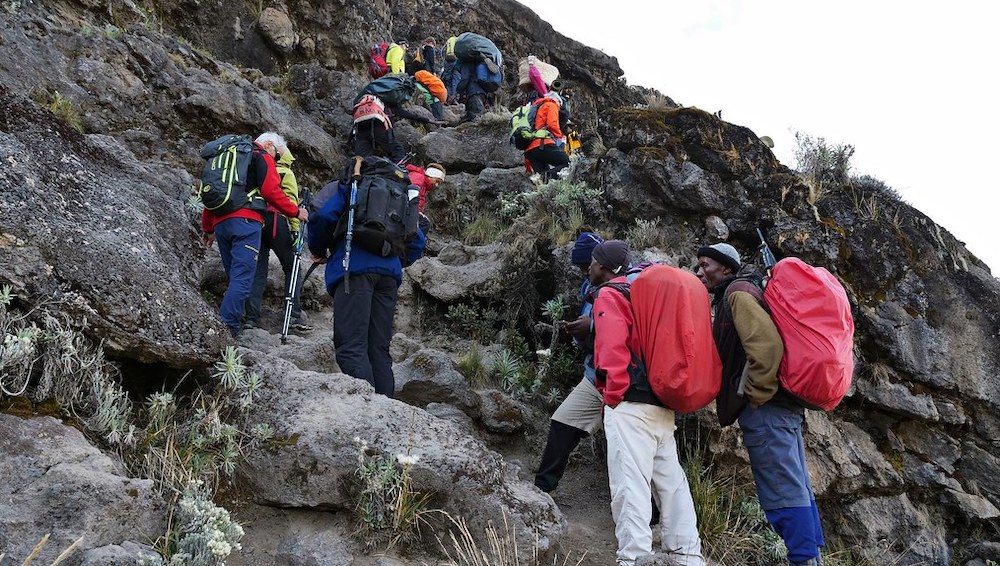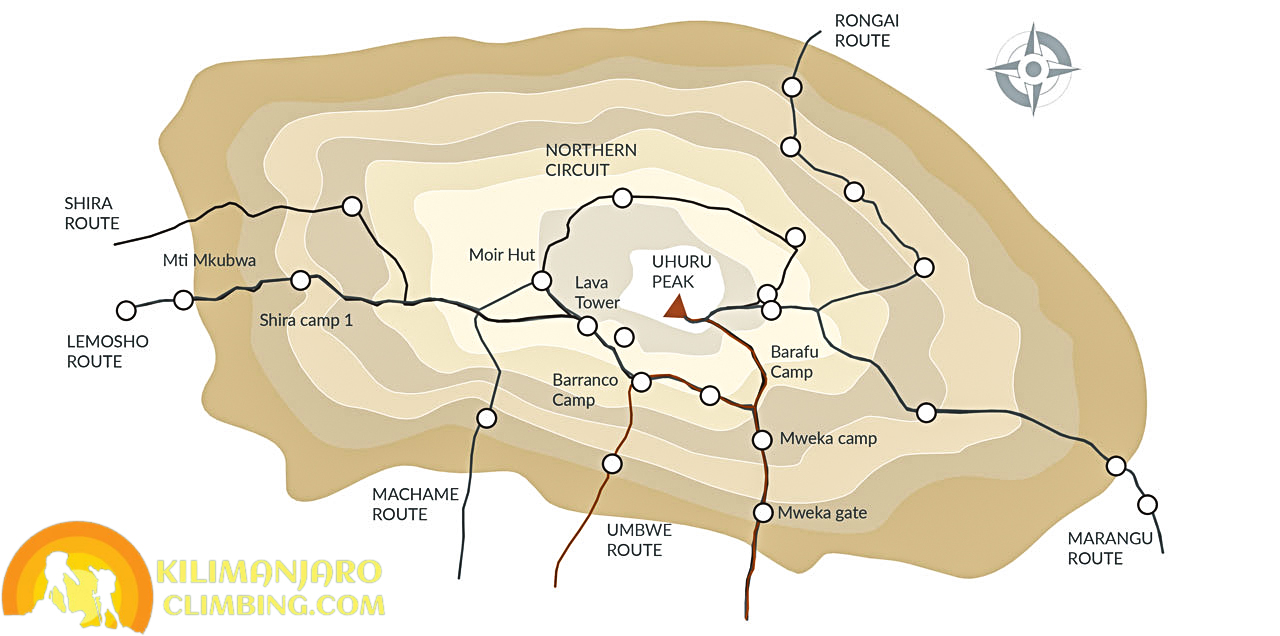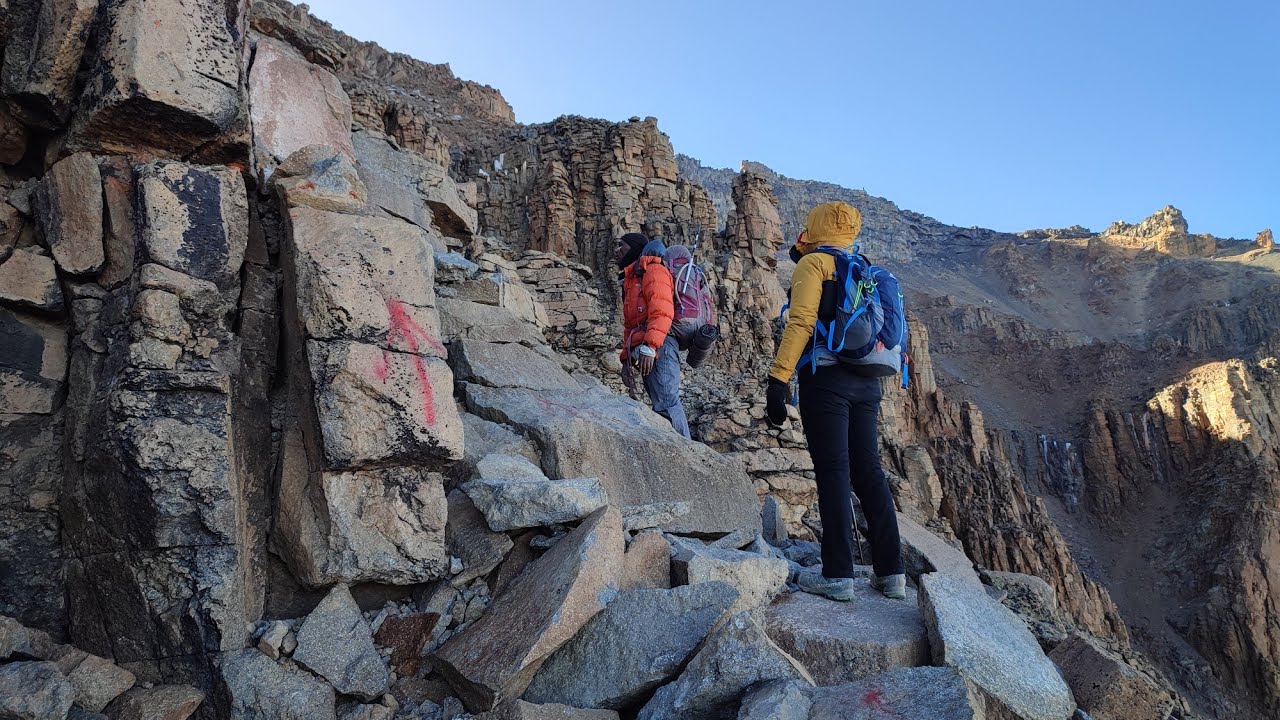The Umbwe Route is one of Mount Kilimanjaro’s least-used routes and one of the least crowded. The hike starts from the south side of Kilimanjaro, a difficult hike that is quite challenging both physically and mentally, and the hike is straight 5895 m to Uhuru Peak. The scenery is beautiful, with the first two days taking you through the rainforest zones before passing through the different climatic zones that are found along Mount Kilimanjaro. It is a 53-kilometer route that has spectacular views of the surrounding areas, and it also happens to be one of the quietest routes on the mountain, so if you are looking to enjoy the wild and untouched side of Kilimanjaro, the Umbwe Route is the right choice for you.
A few quick facts about the Umbwe Route include it being the shortest hike route, quite challenging; you need to have prior experience with mountain climbing or you can have pre-acclimatization before choosing this route; it is the steepest hike route approaching the mountain from the south; and it can trek between 5 and 7 days.
How many days is the Umbwe Route?
The Umbwe Route can be completed in either 5 days, 6 days, or 7 days. Still, for better chances of getting to the summit, we recommend that you take the 6-day Kilimanjaro Climbing via Umbwe Route or the 7-day itinerary for the Umbwe Route for better acclimatization. Take your time as you climb Mount Kilimanjaro using Umbwe because this is not a race and you at least have to enjoy the views.
The success rate on the Umbwe Route

This is one of the most direct and shortest hikes up Mount Kilimanjaro, and this means that hikers do not get a chance to acclimatize, leading to an extremely low success rate. Although we have no official statistics, the average success rate for the 5-day Umbwe Route is 50%. That is a low success rate due to poor acclimatization.
How hard is the Umbwe climb?
The Umbwe Route is one of the hardest and steepest routes on Mount Kilimanjaro. The route is a direct one, taking the steep climb upwards in the northern direction towards the Barranco Wall. From the Barranco Wall, it will head directly to the Shira, Machame, and Lemosho routes, which should be avoided at all costs by hikers who are not physically fit and have no prior experience with hiking steep mountains, rocks, and drops.
When is the best time to use the Umbwe Route?
Although the mountain is open for hikes throughout the year, the best time to use the Umbwe Route is from July to September during the dry season. The wet season, which is April to May, should be avoided at all costs.
The sleeping arrangements on the Umbwe Route are camps only, and the only route along Mount Kilimanjaro with hut accommodation is the Marangu Route. Sleeping equipment like sleeping bags, mats, tents, and pillows are provided, and the dedicated mountain crew will be around to help pitch and remove the tents for the next campsite.
The advantages of using the Umbwe Route are that it is the shortest route and therefore does not take up much time for the hikers; it is not usually used by hikers, making it the ideal route for hikers avoiding large crowds; it has beautiful scenery; and it is not that expensive like the Northern Circuit Route.
The Umbwe Route, however, comes with a lot of cons, which include the following:
- It is not suitable for hikers who are not well experienced with steep hikes and have zero pre-acclimatization.
- It has a meager summit success rate because of its direct and steep nature.
There are a few considerations that need to be put in place if you are to use the Umbwe Route, and these are:
Time for climbing the mountain: picking the route can be damaging, especially if it is your first time, so you need to find out the best time to attempt the Umbwe Route. If you are planning on using Umbwe, the best time is during the dry season, from July to September, when the hiking route is not slippery since it is steep.
How much time you have is a huge determinant of the type of route to be used while hiking Mount Kilimanjaro. Climbing the mountain is a huge discomfort if you do not get enough rest, so choose the Umbwe Route if you believe you can take the discomfort that comes with it.
Reason for climbing Mount Kilimanjaro: If getting to the summit is the ultimate goal, then get a hiking route that has a high success rate. And you should take into consideration the physical fitness of the team that you are hiking with.
Umbwe Route Map & Location; Where Is Umbwe Route Located?
The Umbwe route is located on the southern foot slopes of Mount Kilimanjaro, the Umbwe route stands as a trail accessible with ease, yet renowned for its formidable reputation as one of the most challenging paths on the mountain. Commencing its ascent from the southern base of Mount Kilimanjaro, the route charts an upward course towards the Southern Ice field, culminating at the Barafu, which serves as its summit starting point. Unlike other routes, the Umbwe route opts to bypass the Crater Camp during its ascent.

The Umbwe route distinguishes itself with a steep vertical ascent, veering northward until it intersects with the Barranco Wall. This juncture marks the convergence of the Umbwe route with Mount Kilimanjaro’s Shira, Lemosho, and Machame routes, creating a nexus of trails that contribute to the diverse tapestry of experiences on the mountain. As climbers navigate the challenging terrain of the Umbwe route, they not only conquer the physical ascent but also immerse themselves in the unique features and landscapes that characterize this particular trail.
A Comparison of the Six-Day and Seven-Day Umbwe Route Options.
Comparing the six-day and seven-day itineraries of the Umbwe Route reveals a notable difference, each offering a unique perspective on conquering Mount Kilimanjaro Climbing. This additional day not only enhances your chances of summit success but also allows you to savor the mesmerizing landscapes and absorb the unparalleled beauty of Mount Kilimanjaro: This extra day is for acclimatization at Barranco Camp.
A Detailed Breakdown of the day-to-day Itinerary for the Umbwe route.
Here is the day-to-day breakdown of the Umbwe route itinerary, outlining the accommodations and sleep arrangements along the Umbwe Route, along with the corresponding number of days.


